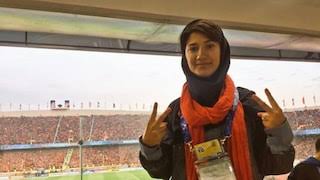
For years, Niloofar Hamedi, an Iranian journalist specializing in women’s rights, was able to publish shocking stories without being exposed—that is, until the day she snapped a photo of Mahsa Amini’s parents holding hands in a hospital in Tehran where their daughter was being treated for a coma.
The image, which Hamedi shared on Twitter on September 16, was the first indication to the outside world that everything was not right with 22-year-old Amini, who had been arrested three days prior for what the Iranian morality police believed to be an improper dress.
Protests across Iran
Amini’s passing later that day would spark a wave of widespread protests across Iran that were still going strong, despite a government crackdown, nearly three weeks later in various parts of the country.
The image of Amini’s parents was also one of Hamedi’s last posts before she was arrested a few days later and her Twitter account was suspended. Hamedi worked for the pro-reform daily Sharq.
Hamedi’s visit to Amini
On September 16, Hamedi was able to visit the Tehran hospital where Amini was being treated after being imprisoned by Gasht-e Ershad. The Kurdish woman’s parents challenged the authorities’ assertion that she had a sudden heart attack.
A photo of the parents sobbing at the hospital while Amini was being treated for a coma was tweeted by Hamedi. This demonstrated that there were problems with the young woman. Amini passed away later that day, and her passing sparked widespread protests across Iran that are still going on today.
Hamedi’s attorney presses on matters
According to a letter from Hamedi’s attorney, he has not been charged and is being detained in isolation in Iran’s Evin prison.
The authorities have used force to quell the largest display of public opposition in years, posing one of the strongest threats to the Islamic Republic since the 1979 revolution.
According to rights groups, security forces have murdered at least 185 people, including 19 juveniles, injured hundreds, and detained thousands more. More than 20 members of the security forces have reportedly died, and the Iranian government says it will look into reports of civilian fatalities.
How did Hamedi end up in prison?
Her arrest comes after authorities detained Shargh daily journalist Nilufar Hamedi, who visited the hospital where Amini was being treated for a coma and contributed to the case’s global exposure.
Hamedi is still detained and is housed in Tehran’s Evin jail, and according to her husband, she is unaware of the accusations leveled against her.
Rights organizations charge Iran with rounding up numerous critical journalists who are still present in the nation, focusing in particular on those who have covered the Amini case. Access to the internet is also highly constrained.
As of Monday, at least 19 additional journalists had also been taken into custody, according to the Committee to Protect Journalists (CPJ).
For Hamedi’s coworkers, it has become a daily worry to be a journalist at a reformist publication that has been a thorn in the side of Iran’s ruling conservatives.
As per Reporters Without Borders’ World Press Freedom Index, Iran is among the ten least free countries in the world for the media and is still one of the most oppressive.
Iran is a county that illegally takes away press freedom
While press freedom is guaranteed by Article 24 of the constitution, the 1986 press law (which was updated in 2000 and 2009 to account for online publications) gives the government the power to make sure that journalists don’t “endanger the Islamic Republic,” “offend the clergy and the Supreme Leader,” or “spread false information.”
Will the scenario ever change? Will Hamidi get her freedom back? More importantly, will Iranian women get their freedom? Guess, we will have to see.